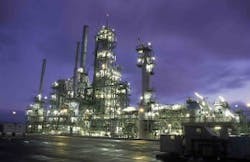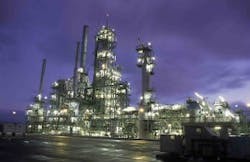WirelessHART Technology Optimizes Refinery Corrosion Monitoring
The growing demand for transportation fuels and the shift toward diesel makes hydroprocessing increasingly important. Hydroprocessing units help the refining industry meet global demand for cleaner fuels, even with an increasingly challenging feedstock of heavier crude slates with higher contaminant levels. Hydroprocessing units are key components of a competitive refinery configuration to shift available feedstocks into desirable and marketable product distributions.
In these units, hydrocarbon intermediates and products are reacted with hydrogen in the presence of a catalyst to produce high-value clean and lighter products. Feedstock and operating conditions such as temperature, partial hydrogen and absolute system pressure depend on the final application. Feedstocks can include every refinery intermediate and product, as well as straight-run and cracked feedstocks.
Higher system pressures and the appropriate catalyst generally enable a deeper chemical conversion and cracking of carbon-carbon bonds, while milder hydroprocessing removes contaminants.
Two of the major hydroprocessing applications are hydrotreating and hydrocracking.
Hydrotreating removes undesired feedstock components and reduces contaminants, such as sulfur and nitrogen, to avoid catalyst poisoning and mitigate downstream corrosion. Hydrocarbon components such as aromatics are removed to enhance product qualities. Blending pool properties like cetane number, density and smoke point can be improved with customized catalysts and process configurations. Dewaxing capabilities of certain catalysts improve cold-flow properties for blending components in the middle distillate pool.
Hydrocrackers break down carbon-carbon bonds of a heavy feed to produce higher value products, such as gasoline, kerosene and diesel components. A hydrocracker uses significant quantities of hydrogen, which is boosted to 150-bar pressure by large gas compressors. Sulfur and nitrogen in the first stage hydrocracker are removed by adding hydrogen to the feed, heating this mixture in a furnace, and passing the feed into high-pressure reactor vessels over a catalyst.
Corrosion has become an important issue in refineries as incoming crude conditions change and plants age. By following best practices in design, chemical treatment and corrosion monitoring, refineries can address corrosion risk.
Corrosion mitigation strategies, such as controlling flow and operating temperatures, as well as adding chemical inhibitors and water injection, can be very effective in hydroprocessing applications. However, to determine efficacy, it is best practice to continuously measure wall thickness and compare relative measurements over time.
Several corrosion-monitoring tools are available with different benefits and limitations, including in-line probes and non-intrusive sensors. Often, a combination of technologies will give the most comprehensive and reliable information. In-line probes and ultrasonic sensors can also be combined in the same wireless network.
Ultrasonic corrosion monitoring is one of the technologies available. It is suitable for this purpose as it provides the data required to make proper decisions on a continuous basis, and provide this information directly to plant personnel.
The installation costs of WirelessHART-based ultrasonic sensors are low, as they do not require intrusion into the process. Process shutdown is not required because sensors are installed without pipe penetrations. Wireless data retrieval enables cable-free installation, further reducing installation and operating costs. The sensor power modules are designed to last until the next plant turnaround (typically, nine years is achievable), so no access is required between turnarounds. Sensors are often installed as multi-point arrays at high-risk locations to provide more detailed information.
Ultrasound measurements are affected by process temperature variations due to the change in speed of sound through the metal. The latest generation of corrosion sensors uses an integrated thermocouple to measure the metal surface temperature, and can automatically compensate wall thickness measurements for temperature variations.
Once installed, these sensors measure the thickness of the pipe wall and send data directly to server-based analysis software via a wireless network, or to any plant monitoring system. This allows refinery engineers to analyze the effectiveness of anti-corrosion measures.
Corrosion control techniques can be effective when evaluated for efficacy and optimized in real time. This can be accomplished with ultrasonic corrosion sensors.
For more information, please visit the FieldComm Group website.
About the Author
FieldComm Group
FieldComm Group

Leaders relevant to this article:

